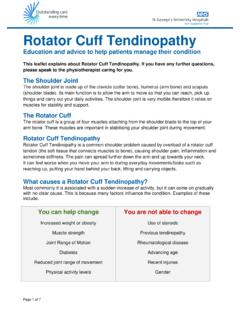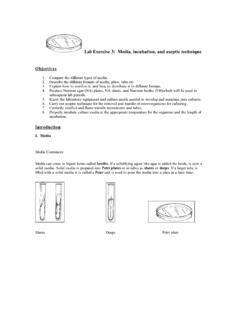Transcription of Aseptic Non Touch and Clean Technique Protocol
1 Page 1 of 11 Aseptic Non Touch and Clean Technique Protocol Policy Profile Policy Reference: Appendix D Clinical care Protocol 5 Version: Version 2 Author: Senior Infection Control Nurse Executive Sponsor: Director of Infection Prevention and Control Target audience: All Trust Staff Date issued: 5 April 2012 Review date: March 2015 Consultation ICC Dates 2012 Key individuals and committees consulted during drafting Dates Approval Approval Committee: Infection Control Committee Date: 2012 Ratification Ratification Committee: Policy Ratification Group Date: 15 March 2012 Document History Version Date Review date Comments V1 2007 2010 V2 April 2012 March 2015 Reviewed and revised to take account of latest guidance.
2 Page 2 of 11 Contents Page Executive Summary 3 1 Introduction 4 2 Definitions 4 3 Aims of Aseptic Technique 5 4 Indications for Aseptic Technique 5 5 Procedure Guidelines: Aseptic Technique 5 6 Clean Technique 7 7. Education and Training 8 8 Audit 8 9 Related Policies 8 10 Appendix A References Aseptic Technique Competence Based Assessment Form 9 10 Infection Control Policy 2010, Appendix D, Universal Precautions Protocol (7) Page 3 of 11 Executive Summary Aseptic means without micro-organisms.
3 Aseptic Technique refers to the practice used to avoid the introduction of pathogenic organisms. The main aims of an Aseptic Technique are to protect the patient from contamination by pathogenic organisms during medical and nursing procedures and to protect the health care worker during nursing and medical procedures from being exposed to potentially infectious blood and body fluids. This can be achieved by ensuring that only sterile equipment and fluids are used during invasive medical and nursing procedures . This Protocol applies to all staff including contractors and agency/ locum staff and volunteers that work in the Trust who provide care or treatment, accommodation, or related services to patients.
4 This Protocol is an appendix to the Infection Control Policy. Refer to the Infection Control Policy for information on the criteria, responsibilities and systems required to prevent and control Healthcare Associated Infections (HCAIs). Infection Control Policy 2010, Appendix D, Universal Precautions Protocol (7) Page 4 of 11 1. Introduction The impact of Healthcare Associated Infection (HCAI) has driven measures to prevent and reduce risk throughout the patient journey. Tackling HCAI is a priority for all National Health Service organisations and staff are required to adopt a zero tolerance to all avoidable HCAIs (DH 2011) In order to improve infection prevention and control practice it is important that measures known to reduce the risk of infection are rigorously and consistently applied.
5 The Health and Social Care Act 2008 requires the following in relation to Aseptic Technique ; Education and training Standardization Assessment Audit Aseptic Technique includes proper hand hygiene, proper preparation of the work area and proper handling of equipment and supplies. There are two types of asepsis: medical and surgical asepsis. Medical or Clean asepsis reduces the number of organisms and prevents their spread; surgical or sterile asepsis includes procedures to eliminate micro-organisms from an area and is practiced by healthcare workers in operating theatres and treatment areas.
6 Dressing of wounds healing by secondary intention requires a Clean Technique however if these wounds enter deeper sterile body areas, then an Aseptic Technique must be used. 2 . Definitions Aseptic means without micro-organisms. Aseptic Technique is the practice of carrying out a procedure in such a way that you minimize the risk of introducing contamination into a vulnerable area or contaminating an invasive device. Medical asepsis aims to reduce the number of organisms and prevent their spread and is mainly employed in ward areas and other treatment areas such as out-patient clinics.
7 Surgical asepsis includes procedures to eliminate micro-organisms from an area and is practised by nurses in operating theatres and treatment areas for invasive procedures such as the insertion of a central venous catheter. A Non- Touch Technique means that the part of the sterile equipment that comes in contact with the susceptible site is not contaminated. A Clean Technique is a modified Aseptic Technique and aims to avoid introducing micro-organisms to a susceptible site, the use of sterile equipment is not crucial. A Sterile Field is an area created by placing sterile towels or surgical drapes around the procedure site and on the trolley that will hold sterile equipment required during the procedure.
8 Hand Hygiene refers to the process of hand decontamination during which there is physical removal of blood, body fluids and the removal or destruction of micro-organisms from the hands Infection Control Policy 2010, Appendix D, Universal Precautions Protocol (7) Page 5 of 11 3. Aims of an Non Touch Aseptic Technique 1. To reduce the risk of introducing potentially pathogenic micro-organisms into susceptible sites such as wounds, blood or the bladder. 2. To prevent the transfer of potentially pathogenic micro-organisms from one patient to another.
9 3. To prevent the transfer of pathogens from patients to staff. 4. Indications for a Non Touch Aseptic Technique An Aseptic Technique is indicated for any invasive procedure that bypasses the body s natural defenses. Whilst it is difficult to maintain sterility, it is important to prevent contamination of sterile equipment. Indications: Insertion and ongoing care of intravenous devices peripherally inserted cannulae, central venous catheters. Urinary catheterisation. Care of wounds healing by primary intention before the surface skin has sealed.
10 Suturing. Insertion of gastrostomy and jejunostomy tubes. Insertion of tracheostomy tubes or chest drains. Vaginal examination during labour. Medical invasive procedures . NB. This is not an exhaustive list and the need to use an Aseptic or Clean Technique should be risk assessed by a qualified healthcare professional. 5. Procedure Guidelines: Aseptic Technique Assessment and Competency The competency of individual staff must be assessed using the competency tool (see Appendix A) if there is cause for concern regarding practice.












